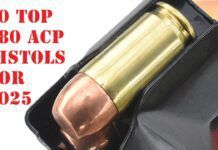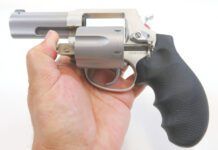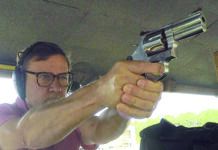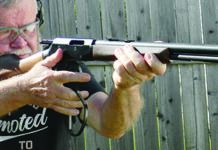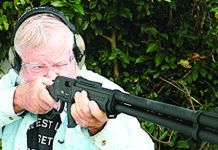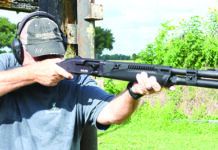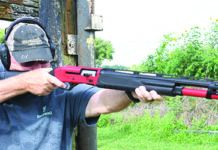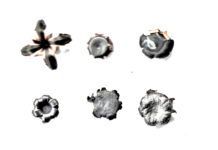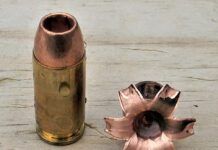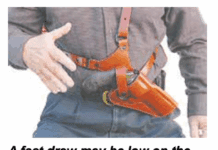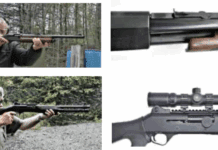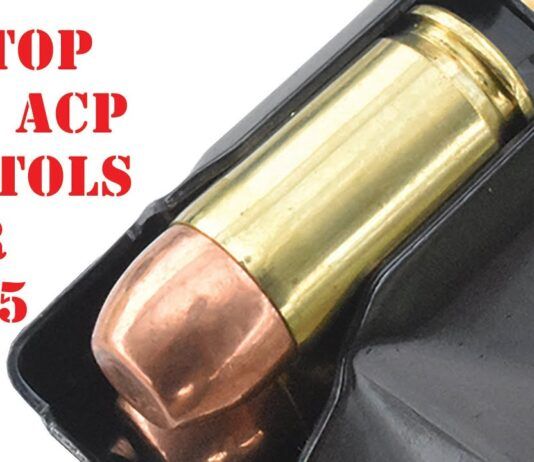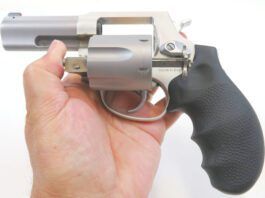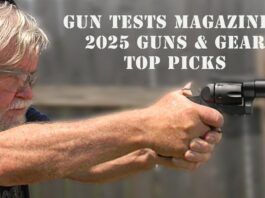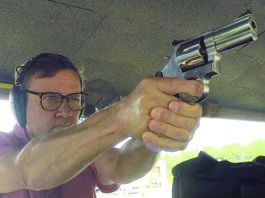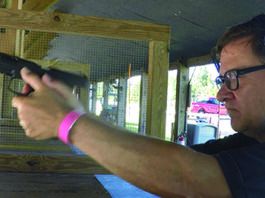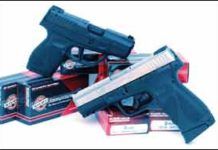GunReports.com SHOT Video: The Thompson 1927A-1 Deluxe Pistol TA5100D
Gun Tests Contributing Editor Roger Eckstine takes a quick look at the Thompson 1927A-1 Deluxe Pistol TA5100D.
GunReports.com SHOT Video: Shooting the Chiappa Revolver
Gun Tests Contributing Editor Roger Eckstine shoots the Chiappa Rhino revolver and remarks on the unusual recoil sensation.
“Statue of Liberty” GlockAuctioned for More Than $15,000
Glock, Inc. has announced its highest bidder for the “Glock Statue of Liberty Gun,” the one-of-a-kind, hand-engraved Glock 22, which served as the official Handgun for the 2012 SHOT Show Auction. The gun sold to Alexander Wilson for $15,025, which will benefit programs to further America’s hunting and shooting sports heritage.
9mm Handguns Big and Small: Taurus, Walther, DiamondBack
The practice of carrying a second gun is nothing new. Pairing a six-shooter with a pistol-caliber carbine or carrying a big service revolver on the hip with a small-framed 5-shot revolver hidden elsewhere are good examples of an effective defensive duo. In this test we looked at two high-capacity 9mm pistols and tried to match them to a pair of smaller pistols of the same caliber.Our first pair was the $498 Taurus PT 24/7 G2 and the much smaller $483 709B Slim pistol. Both guns utilize double-action and single-action fire. Our second pair featured full-time double-action triggers, but from different makers. They were the $729 Walther PPQ and the very small $490 Diamondback DB9. We hate to spoil the surprise so early in the article, but our shooters werent completely satisfied with any combination of these guns in big/little pairs.Though its seems like the two Taurus guns might go well together, they displayed very different characteristics that could interfere with transitioning easily between them. Also, as we detail below, we didnt like the Walther well enough to recommend it alone, so we likewise wouldnt pair it with a smaller gun. The Diamondback was painful to shoot, so that nixes it as a pairable backup, in our view.So, instead, we simply evaluated the pistols individually. Since methods of concealment vary with situation or code of dress, we also considered each of the smaller guns for the role of primary gun as well as for backup.
SHOT Video: Gun Tests Magazine Designates Ruger LCR-BGXS As 2011 “Best in Class Revolver”
Gun Tests Magazine has named the Ruger Lightweight Compact Revolver LCR-BGXS as the publication’s “Best in Class Revolver” for 2011. The pistol joins a Kel-Tec PMR-30, an AR-style 300 Whisper from SSK Industries, a 12-gauge autoloading shotgun from Legacy Sports International, and a laser/light combo accessory from Crimson Trace as the magazine’s “Best in Class” 2011 honorees.
SHOT Show Video: Features of the Mass-Legal Kahr PM9 9mm Pistol
At SHOT Show 2012, Gun Tests Contributing Editor Roger Eckstine covers the features of the Massachusetts-legal Kahr PM9 pistol.
Hoffman’s Honored asRuger Retailer of the Year
Ruger has announced that Hoffman's Gun Center & Indoor Shooting Range of Newington, CT has been named the 2011 Ruger Retailer of the Year. Owner Scott Hoffman received an engraved Mark III pistol to recognize his support for Ruger and his success in the retail firearms industry.
SHOT Show Video: Springfield Armory’s new XDS 45
Gun Tests’ Contributing Editor Roger Eckstine found Springfield’s brand-new XDS .45 at the Media Range Day at the SHOT Show a couple of weeks ago. The micro-sized XDS was secret, and no one knew that the gun, smaller than a Glock 36, existed until media members showed up and saw the 4-inch-tall .45.
SHOT Show Video: Easy Disassembly for the Modular Beretta Nano
Beretta USA introduced the BU-9 Nano as its entry into the pocket 9mm pistol category last September. Initial shipments of the American-made pistol left the Accokeek, Maryland factory beginning in November 2011, with a suggested retail price of $475. In this video, Gun Tests’ Contributing Editor Roger Eckstine gets a detailed explanation of how easy the Nano is to break down for maintenance. The Nano's modularity provides for simple disassembly and easy cleaning. Safely disassemble the pistol by first engaging the striker deactivator, a patent pending safety mechanism that eliminates the need to pull the trigger prior to disassembly.
SHOT Show Video: Two Big-Hole Wheelguns from Kahr Arms
In June 2010, Kahr Arms purchased Minnesota-based firearms manufacturer, Magnum Research, Inc., maker of the Desert Eagle Pistol and BFR Revolvers in .44 Magnum, .45 LC/.410 or .45/70. Kahr Arms offers a selection of other niche-type firearms, such as the “Tommy Gun” and Auto-Ordnance line of M1 .30 caliber carbines. In this video, Gun Tests Contributing Editor Roger Eckstine shows off two of the company’s big-hole BFR wheelguns.
CrossBreed HolstersOffers SuperSlide for 2012
Holster manufacturer CrossBreed Holsters, LLC has introduced a new OWB product for 2012, the SuperSlide.
What CTD’s Top-Selling HandgunsSay About the Market
Though most shooters know CheaperThanDirt.com as an online ammo and accessories seller, the company also has a sizable brick-and-mortar retail gunstore presence in Texas’s Dallas-Ft. Worth area. CTD recently released a list of its top-five selling handguns for December, and the company's top-sellers for the Christmas season show a decided tilt toward affordability and utility.


